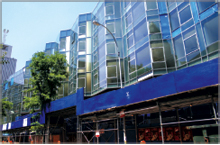Trending
A new holy grail for loans
Lenders are loosening requirements when it comes to issuing mortgages in new condos
 The Dillon
The DillonWhile having 51 percent of a building already sold (and sometimes 71 percent) is still the gold standard, an increasing number of lenders have started easing their requirements for issuing mortgages to buyers in new condos in the city.
Brokers and mortgage bankers say that while the trend started last year, with the recent improvement in the market, they’ve seen a new flurry of activity well below the 51 percent mark.
They say more lenders, ranging from private banks to mortgage banks to private investors, are now willing to lend to buyers in buildings where as little as 25 or 30 percent — and in some cases even less — of the total units have been sold.
“More people are creeping into this market,” said Andy Gerringer, managing director at the Marketing Directors, a sales and marketing firm for developers. “Numbers have come down as low as 30 percent, and people see an opportunity.”
The new, looser lending climate reflects several major changes, including the fact that the Dow Jones Industrial Average has shot up dramatically since its 2009 low of just over 6,500 points (it’s now above 10,000), helping to bolster consumer confidence as the recession has waned. Developers are also shoring up buyer and lender confidence by delaying sales until buildings are nearly complete.
Meanwhile, in December 2009, the Federal Housing Administration eased its guidelines to back loans in buildings that are just 30 percent sold rather than 50 percent.
Rolan Shnayder, director of new development lending at Manhattan-based mortgage bank Home Owners Mortgage, said his company expects to originate 1,000 FHA loans this year, a tenfold jump from last year. That, he said, is a direct result of the FHA easing its requirements and more local buildings obtaining FHA approval (see “The truth about FHA”).
Home Owners Mortgage has lent to buyers for apartments in dozens of new developments in Manhattan and Brooklyn, from the Dillon in Hell’s Kitchen to the Setai in Lower Manhattan and be@schermerhorn in Downtown Brooklyn.
The Dillon, an 83-unit glass condo tower at 425 West 53rd Street, which was conceived back in 2005 and just began sales, represents the new era of new development sales and lending.
The project stumbled with the economy and hit the skids last year when the Federal Deposit Insurance Corp. took over the building’s failing lender, Corus Bank. Developer SDS Procida Development Group was not able to proceed until after an investor group bought the construction loan.
In May, Corcoran Sunshine Marketing Group threw a splashy bash to kick-start sales. Unlike boom-time sales, which sometimes took place 18 months before completion and were based on little more than architectural drawings, this project is being sold while nearly complete.
Corcoran Sunshine managing director Elaine Diratz, who is handling sales at the project, said the Dillon inked about 15 contracts in the first month of sales. That’s about 18 percent of the building.
In the past, that low percentage would have made it difficult for interested buyers to secure mortgages, creating a Catch-22 for the building. But the lending environment has started to change.
Both Home Owners Mortgage and Manhattan Mortgage are originating loans for the Dillon’s initial round of deals.
These kinds of mortgages are considered riskier than loans on buildings that are more than half sold, and they carry a higher cost as a result. The premium on a 30-year fixed mortgage in a largely unsold new development building ranges from half a percentage point to 2 percent.
This high premium is dissuading some buyers.
Julie Teitel, senior vice president at Manhattan-based mortgage banker Guardhill Financial, said she’s receiving a lot more inquiries now than a year ago at this time from buyers wanting mortgages on condos only 30 percent sold. But an interest rate of 7 percent, compared to the 5 percent or better rates common today, means she’s only locking up deals for two out of 10 of these inquiries.
Still, anyone who wants to shop around for a mortgage for a purchase in a new development that is less than 50 percent sold has a growing array of options.
Smaller and regional banks, such as Investors Savings Bank, are making these loans.
Richard Spengler, vice president and chief lending officer at New Jersey-based Investors Savings Bank, said the bank is willing to lend at 25 percent sold. Yet he noted that lenders limit the number of these deals in any one building. He said his bank will finance 10 percent of the units once a building is 25 percent sold, and 20 percent of the units once it’s 50 percent sold.
Meanwhile, Deutsche Bank Private Wealth management is making these loans on a very limited and conservative basis, according to an industry source.
Even private investors are getting in on the action. According to Teitel, private investors looking for a better return than the stock market provides are willing to make loans of $250,000 to $500,000 to buyers who want a condo for an investment, not a first or second home.
This wave of deals can benefit buyers by helping them score low introductory pricing on a new condo. Prices generally rise 10 percent or more as sales climb above the 50 percent mark.
But there are, of course, a lot of risks still associated with new development lending as the economy struggles toward sustained recovery.
“The [risk for the bank] is the same risk for the buyer — that the building goes stale and nothing gets sold and the building ends up in foreclosure,” said Home Owners’ Shnayder.




